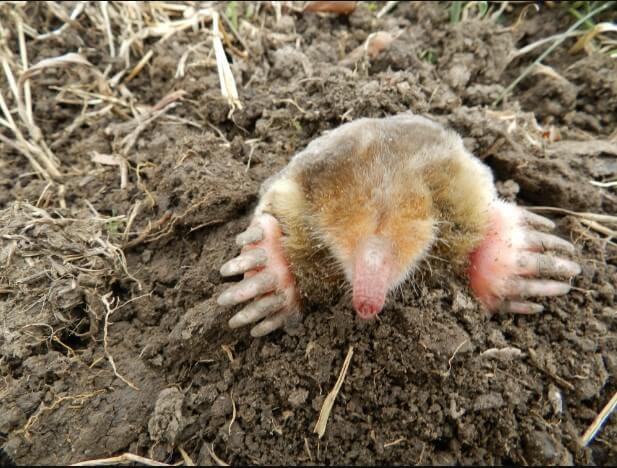
The Eastern Mole
Moles are small mammals that spend most of their lives under the soil in burrows. Very rarely are they seen above ground. In appearance they resemble shrews but are larger in size. Only one species occurs in Missouri and Kansas. That is the Eastern Mole. The conspicuous features on the mole are their large paddle like webbed front feet. These they use to practically swim thru the soil. They are extraordinarily strong for their size. They lack any visible ears, and their eyes are so small that they appear to be non-existent. The eyes of moles are only used to distinguish light and dark. They rely mostly on hair follicles around their nose to detect food and movement. The nostril is an important tool for the mole.
A mole’s fur is soft and brownish to grayish with a common light patch somewhere under the (belly) chin area. The fur can move forward or backward to allow the mole to quickly escape predators.
Moles prefer loose, sandy loam soils. They avoid heavy clay soils. Digging their burrows is a fuel burning activity that they must undertake. Some tunnels that are dug are used for feeding, some for travel from feeding area to nesting. Some tunnels particularly the feeding tunnels may never be used again. Large mounds of soil often indicate deeper travel tunnel activity and nesting chamber construction.
Moles breed in late winter to early spring. Gestation last for about four to six weeks. Annual litter amount consists of two to five young born in either March, April or May.
Habitat preference is open woodlands, grasslands and lawns. Moist areas within this habitat is often preferred for the large population of earthworms present. They feed almost exclusively on invertebrates within the soil. They may take small amounts for roots and or tubers within their tunnels. They have a high metabolism.
They eat destructive insects that could cause damage to the landscaping. Unfortunately, this tunneling; searching for insects, indirectly can cause damage to root systems of flowers, bulbs and the lawn.
Spotting Problem Moles
Mounds of dirt in your yard is probably the most obvious sign that you have a mole present. The mounds are usually an indication of a deeper tunneling system for the winter or a nesting area in the spring. Dirt is pushed up thru the center of the mound.
Tunneling activity is usually obvious as well. If you step on these tunnels they will collapse. The moles tunneling will rip the roots out of the soil causing stripes in the grass in the summer months.
Trial and Error Control Techniques
The mole seems to be able to pull a “Houdini” escape act when homeowners try and capture them. Their ability to avoid capture and sense danger is uncanny. People have always had many ideas how best to get rid of their mole problem. Following is a summary of the most common.
Habitat Modification – Packing soil with a roller, can reduce mole activity.
Insecticides – Because mole are insectivores they feed mostly on worms and other insects. So this may reduce the food source to a degree.
Repellents – Mothballs are occasionally mentioned as a mole remedy. There is no data to substantiate this method.
Toxicants – The poison pellets or poison peanuts are a staple at your local hardware store. Unfortunately, moles do not eat a lot of grain baits. They are insectivores which means, most of their diet consist of insects not grain.
Home Remedies – Last, but not least. The myths. Where to start? Broken glass and chewing gum placed in the tunnels. Plastic flowers or windmills that spin in the wind to create a vibration to scare the mole away. And for the horticulturally inspired the “mole plant” or caper spurge. And of course, the castor bean. Which is suggested planting it in your flower beds.
Not All Moles are a Nuisance.
Before you begin controlling the moles. Make sure that they are a real problem. Moles are a greatly beneficial species. Their digging helps aerate the soil by turning upper soils with the lower layer of soils. Further, they will eat grubs and other damaging insects that can damage to the lawn.
The Best Method for Mole Control: Trapping
Unfortunately, there are no easy or magical way to controlling moles. Trapping is the most reliable way of solving a mole infestation.
